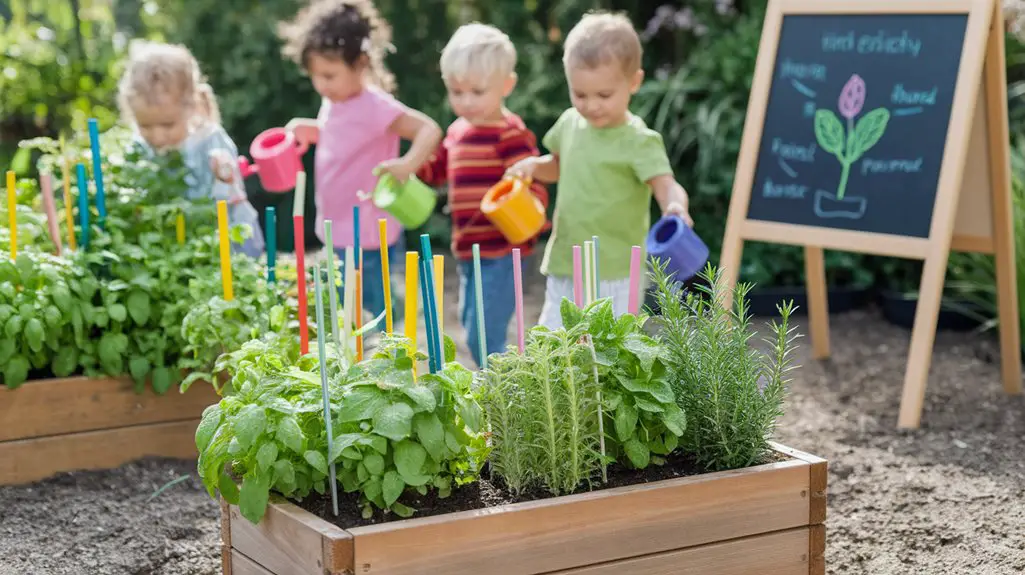Research shows that 73% of children who engage with garden-based learning demonstrate improved academic performance across multiple subjects. You've likely noticed your child's natural curiosity about plants and growing things. By implementing thoughtfully designed herb gardens specifically tailored for young learners, you'll transform this curiosity into structured educational experiences that develop science literacy, sensory awareness, and ecological understanding. The following garden concepts offer practical approaches that extend far beyond simple planting activities.
The Mini Pizza Herb Garden That Teaches Culinary Science
While creating a sensory experience for children, the Mini Pizza Herb Garden combines horticultural education with practical culinary applications.
You'll need a circular container divided into "pizza slice" sections where you'll plant basil, oregano, thyme, rosemary, and parsley—essential pizza herbs.
This configuration teaches children plant taxonomy while demonstrating food origins. The herbs require different watering schedules and sun exposure, introducing botanical science concepts through daily care routines.
Children observe germination rates, growth patterns, and aromatic oil development across herb varieties.
Harvest days become science lessons as you demonstrate how volatile compounds in each herb contribute distinct flavors to pizza sauce.
The garden facilitates experiments comparing dried versus fresh herbs in recipes, analyzing oil concentration through sensory evaluation.
Children learn to identify prime harvest times by evaluating leaf color and aroma intensity. Additionally, they explore how year-round herb gardens can provide fresh flavors throughout all seasons.
Sensory Herb Gardens: Exploring Plant Textures and Aromas
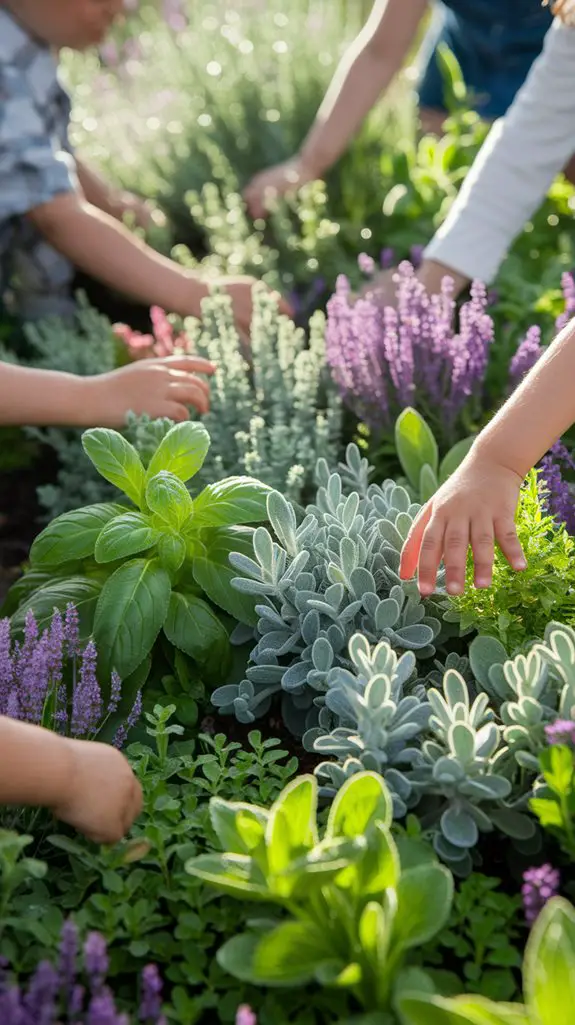
Beyond culinary applications, herbs offer remarkable sensory exploration opportunities for children through dedicated sensory gardens.
Design herb beds that specifically engage multiple senses by incorporating plants with distinct textures and aromas. Include fuzzy lamb's ear, feathery dill, and rough sage to create tactile contrast stations where kids can develop vocabulary through touch identification exercises.
For olfactory stimulation, plant mint varieties (peppermint, chocolate mint), lemon herbs (lemon balm, lemongrass), and lavender in separate zones.
Create "aroma comparison charts" where children record their sensory observations. You'll find these gardens particularly valuable for neurodivergent children who benefit from controlled sensory input.
Consider including "sensory challenge cards" prompting activities like "Find three herbs with different textures" to structure exploration while teaching classification skills. Additionally, incorporating creative herb garden ideas can foster children's interest in gardening while enhancing their sensory experience.
Butterfly and Bee-Friendly Herb Gardens for Pollinator Education
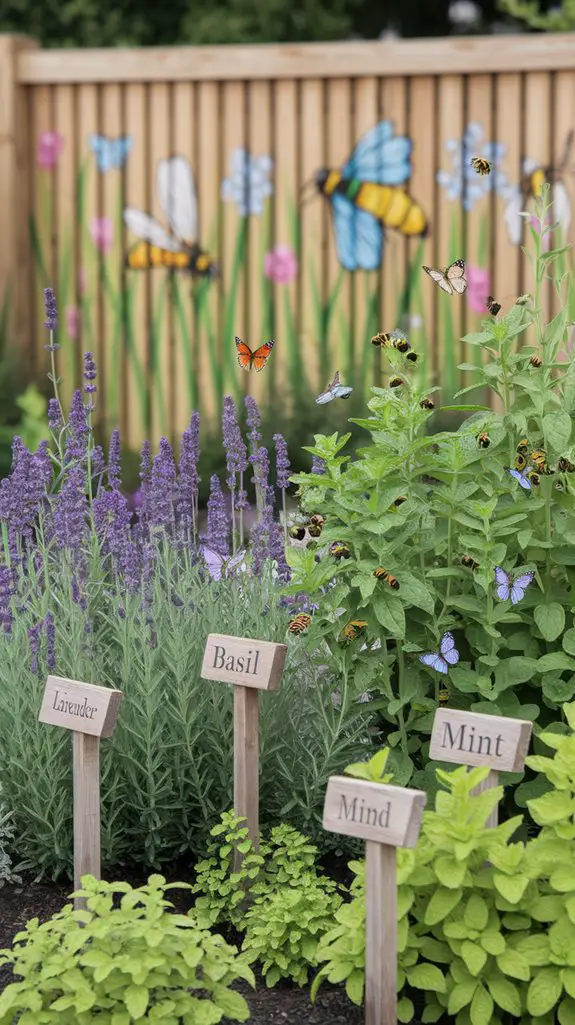
Creating a butterfly and bee-friendly herb garden transforms a simple planting activity into an immersive ecosystem study for children. Select nectar-rich herbs like lavender, mint, oregano, and thyme that attract diverse pollinators. Position these plants in sunny locations where children can safely observe visiting insects.
Incorporate specific pollinator-attracting features: shallow water dishes with pebbles for bee hydration, flat stones for basking butterflies, and varying plant heights to accommodate different species' preferences. Additionally, consider planting pollinator-friendly herbs to enhance the diversity of species in your garden.
You'll want to avoid pesticides entirely, using companion planting instead to manage pests naturally.
Document pollinator visits with children using observation journals or photography. Encourage kids to identify different bee and butterfly species, noting which herbs attract specific pollinators.
This hands-on approach develops their understanding of ecological interdependence and conservation priorities.
Vertical Pallet Herb Gardens for Small Space Learning
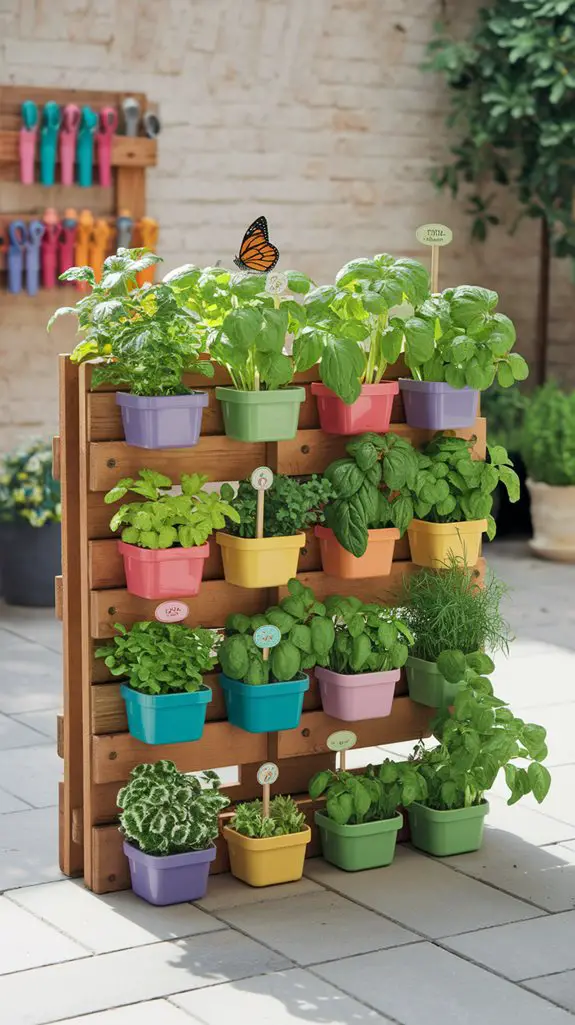
Wood pallets transform into space-efficient vertical herb gardens that maximize growing area while teaching children about vertical gardening principles.
You'll need a standard pallet, landscape fabric, potting soil, and herb seedlings to construct this educational tool.
Secure landscape fabric to the back and sides of your upright pallet using a staple gun, creating soil-retaining pockets between slats. Fill these compartments with quality potting mix, then introduce drought-tolerant herbs like rosemary and thyme in upper sections, with moisture-loving varieties like mint and parsley below.
This arrangement demonstrates gravitational water flow and microclimate creation within a single structure. Children learn spatial organization skills while monitoring how different herbs respond to their specific positions—reinforcing concepts of adaptation and resource competition in limited growing environments. Additionally, they can explore raised garden beds as a method for optimizing plant growth in diverse environments.
Color-Coded Herb Growing Stations for Plant Classification
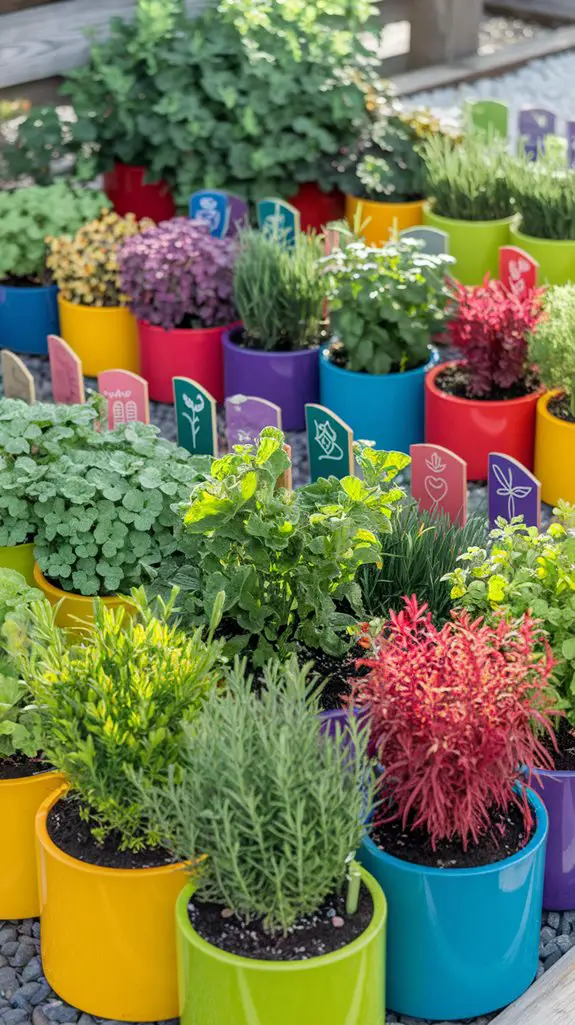
Five distinct color-coded stations transform herb gardening into a taxonomic learning opportunity for children. Organize herbs by botanical families using color systems that reinforce classification principles while teaching botanical relationships.
| Color | Plant Family | Example Herbs | Learning Focus |
|---|---|---|---|
| Purple | Lamiaceae | Basil, Mint, Oregano | Square stems, oils |
| Yellow | Apiaceae | Dill, Parsley, Cilantro | Compound umbels |
| Green | Asteraceae | Tarragon, Chamomile | Composite flowers |
| Red | Solanaceae | Peppers, Ground cherries | Nightshade structure |
You'll need containers in each color, corresponding labels, and family-specific soil mixtures. This system helps children visualize taxonomic relationships while developing identification skills. They'll learn to recognize plant family characteristics—leaf arrangements, stem structures, flower patterns—creating connections between culinary uses and botanical science. Additionally, starting a raised bed herb garden provides an excellent hands-on experience for kids to engage with plants.
Recycled Container Herb Gardens That Teach Sustainability
Transform household discards into functional herb containers that demonstrate ecological principles while cultivating culinary plants. Repurpose plastic milk jugs, tin cans, and cardboard egg cartons by drilling drainage holes and filling with nutrient-rich potting medium.
Each container type offers distinct learning opportunities: transparent containers reveal root development, while metal conductivity affects soil temperature. Additionally, incorporating creative vegetable garden design ideas can enhance the visual appeal and educational value of the garden.
Implement a closed-loop system by collecting rainwater in modified buckets for irrigation and creating compost from kitchen scraps to fertilize your herbs.
Label containers with detailed information about each herb's growth cycle, culinary applications, and environmental benefits. Document the container's original purpose and transformation process to illustrate resource conservation principles.
This hands-on sustainability lesson connects children's daily actions to broader environmental concepts while producing usable herbs for kitchen experiments.
Alphabet Herb Gardens: Growing Plants From a to Z
Cultivate botanical literacy through an alphabetical herb collection that engages children in a systematic exploration of plant diversity while reinforcing language skills. Assign each letter a corresponding herb—anise, basil, cilantro, dill—arranging plants sequentially to create a living alphabet reference.
Implement educational signage featuring each herb's botanical name, culinary applications, and medicinal properties. Children will develop taxonomic comprehension while practicing alphabetization.
Design complementary activities requiring identification of plant characteristics, vocabulary development through sensory exploration, and documentation in botanical journals.
For extensive coverage, include herbs from diverse geographical regions: Japanese shiso, Middle Eastern za'atar, and European tarragon. This approach facilitates cross-disciplinary learning, connecting botanical science with global studies.
You'll observe children progressively mastering plant identification while simultaneously enhancing alphabetical sequencing abilities through this structured horticultural framework.
Conclusion
As you cultivate these herb gardens with your children, you're not merely planting basil or thyme; you're sowing the seeds of botanical literacy. Like Thoreau's Walden experiment, these miniature ecosystems offer profound lessons in sustainability, taxonomy, and ecological interdependence. They'll transform ordinary spaces into living laboratories where children's natural curiosity—their intellectual soil—can nurture both scientific understanding and environmental stewardship for our increasingly fragile biosphere.

